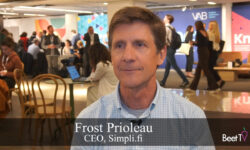At this point in the evolution of digital advertising, there is an increasing focus on supply path optimization (SPO), as companies aim to maximize their ad efficiency.
But, beneath the acronym, how does SPO actually work, and how does it translate to connected TV advertising?
Lara Koenig, Global Head of Product, MiQ, says there are lessons to be learnt from this dynamic landscape that can be applied to other channels.
Shifting Priorities in Advertising
“We’ve learned a lot of lessons about supply path optimization in web environments,” says Koenig in this interview with Beet.TV at Advertising Week New York. “While header bidding isn’t quite as prolific in CTV yet as it is in web, we can learn a lot of lessons from what happened in the omnichannel space and apply it to TV.”
Koenig points out a shift in the conversation, moving away from auction duplication and towards maximizing path alignment with publishers.
“There’s massive differences in terms of the CTV ad positions that are being offered across the various DSPs and SSPs, and how the platforms downstream are actually prioritising those in line,” she observes.
“The conversation shifted more towards how you can maximise the path that you’re buying through to align with the publisher’s priority.”
Making Value Out of Data
MiQ offers programmatic campaign solutions including data analytics, creative build and trading insights, plus analytics and tech solutions.
The focus of Koenig’s role is making value out of data, scrutinising the upstream processes of partners for more direct access to publishers.
“One thing we’re looking at is making value out of data, making use of supply chain logs that are coming through the programmatic ecosystem and scrutinising the upstream places that our partners are buying through so that we’re getting as direct to the publisher as possible,” Koenig explains.
Koenig’s team uses this data to score and grade supply-side platforms (SSPs), ensuring the transparency of their supply. This method also aids in aligning with the publishers’ ad tech stack priority.
“We’re really applying that then to our deal and our packaging plumbing strategy, going direct to publishers as well as preferred SSPs and making sure that we’re buying through a very robust library of first-party CTV deals,” Koenig adds.
Building a Robust Communication Chain
According to Koenig, a common pitfall for buyers is the lack of recognition from publishers when buying through a third-party deal library. To counter this, she advocates for a more direct approach, connecting all parties in the conversation.
“You get more priority and more preferential rates if you’re actually connecting the dots in between.
“Talking to the publisher, the SSP, the DSP, and the buyer all at the same time and collapsing that conversation into one is critical,” Koenig asserts.




































